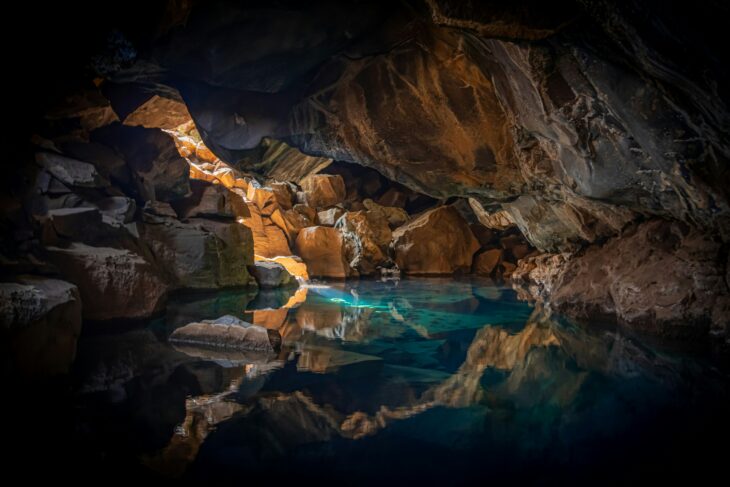Have you ever visited a cave? Most caves are formed from a rock made of calcium and carbonate, called limestone, and contain extensive passages beautifully decorated with unique minerals in columnar formations. For example, Mammoth Cave in Kentucky has 426 miles (or 686 kilometers) of passages and more than a hundred rooms lined with massive stalactites and stalagmites.
Where there are caves, there are often underground reservoirs of water, called aquifers. Aquifers also commonly form in limestone and store vast quantities of water in cracks and other pore spaces in the rock. The human population harvests billions of gallons of water from aquifers every day.
Caves and aquifers form in limestone because chemical reactions between limestone and acid cause the limestone to dissolve. The most common acid that reacts with limestone to form caves and aquifers is carbonic acid. Carbonic acid is a weak acid that naturally forms when carbon dioxide, denoted as CO2, dissolves into water. However, other naturally occurring acids like sulfuric acid and nitric acid can also dissolve limestone.
Scientists have shown that limestone dissolution affects the global climate. When carbonic acid dissolves limestone, it consumes CO2, which is a potent greenhouse gas. However, when other acids dissolve limestone they release CO2 into the atmosphere. In particular, sulfuric and nitric acids are produced during human activities like agriculture and other industrial processes. Scientists want to know if these acids dissolve an appreciable amount of limestone in aquifers and other underground areas.
Recently, a team of researchers from Florida used chemical analyses and mathematical models to measure the amount of limestone dissolution caused by acids other than carbonic acid in a large aquifer known as the Floridan Aquifer. The researchers explained that the Suwannee River sits above the Floridan aquifer, and water from the Suwannee River refills or recharges the aquifer. They wanted to determine how much dissolution could occur in the aquifer with this freshly recharged water.
First, they measured CO2 and the concentration of acids in water samples from different surface and underground locations across the Suwannee River watershed collected over 5 years. Then they used this data to create a mathematical model that calculated the amount of limestone that would dissolve within the aquifer if every molecule of acid in the aquifer reacted with a molecule of limestone.
Using this model, the researchers estimated that acid input into the aquifer could dissolve from 100 to 10,000 kilograms (or 220 to 220,000 pounds) of limestone in 6 months. That is equivalent to the weight of at least 2 humans or more than 3 cars worth of rock dissolving! Based on the model output, they also found that carbonic acid alone couldn’t drive all the limestone dissolution they estimated. The researchers concluded that other acids, like sulfuric and nitric acid, must contribute to limestone dissolution.
The team also explained that water can flow through aquifers in as little as a couple of hours, or as long as a couple of years. They reported that several storms occurred while they were sampling the river, which created surges that increased recharge and pushed water through the aquifer faster than normal. They calculated that the most limestone was dissolved during these storm surges, suggesting storms can exacerbate aquifer growth.
For many Floridians, the Floridan aquifer is their primary source of clean water. So the researchers stressed that how this aquifer interacts with the environment affects the livelihood of millions. The researchers concluded that acids released from human activity could impact limestone dissolution in everything from the aquifers we depend on to the caves we visit. They suggested that future researchers consider rock weathering when studying carbon dioxide dynamics in other limestone-dominated areas.


